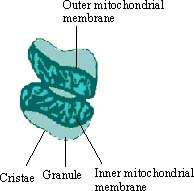|
PinkMonkey Online Study Guide-Biology
Mitochondria : is another organelle of the cell.
It is called the "power house of the cell" because it stores
and releases the energy of the cell. The energy released is used to form
ATP (adenosine triphosphate).

Figure 3.3 A cross-section of a Mitochondrion
Nucleus : Prokaryotic cells donít have a
nucleus but eukaryotic cells have a nucleus situated in the cytoplasm.
The nucleus mainly contains DNA ( i.e., Deoxyribonucleic acid).
DNA is organized into linear units called chromatin. Genes are the
functional segments within the chromosome. Each chromosome consists
of approximately 1,000,000 genes. The chromatin is coiled around
nuclear protiens called histones. When chromatin is coiled, it forms
chromasomes. Genes contain the coding for all the protiens
in a cell of an animal or plant. The nucleus of the cell is surrounded
by an outer membrane called the nuclear envelope. The nuclear
membrane resembles the plasma membrane in its function. It is also
a double layer membrane consisting of two lipid layers similar to
those in the plasma membrane. Pores in the membrane allow the internal
nuclear part to communicate with the cytoplasm of the cell.
Prokaryotic cells donít have a nucleus but they do possess
DNA which exists freely in the cytoplasm. In bacteria a single looped
chromosome consists of 4,000 genes.In plant cells, organelles called chloroplasts
exist. Due to chloroplasts plants look green in color. The chloroplasts
function in the process of photosynthesis.
During this process, chloroplasts convert the energy
in the sunlight into energy of carbohydrate molecules. Energy from the
sun comes in the form of photons i.e. a package of energy which
gets converted into carbohydrate energy. Chloroplasts consist of a green
pigment called chlorophyll. Because chlorophyll molecules absorb
most wavelenghths of light except green, they reflect green light and
appear green to our eyes. chlorophyll is normally present in that area
of a plant where sunlight can reach easily. For example, the leaves and
stem of a plant are green. On the contrary, the roots donít have chloroplast
so they are not green.
Cytoskeleton : is an interconnecting system of fibers
and threads and interwoven molecules that give structure to the cell.
The main component of the cytoskeleton are microtubules, microfilaments
and intermediate filaments. They are all made up of proteins.
Centriole : is another organelle present in the
cell. It is cylindrical in shape and always occurs in pairs. Centrioles
are involved in cell division. Vacuole :Another organelle seen
in the plant cell is the vacuole. The vacuole forms about 75% of the plant
cell. In the vacuole, the plant stores nutrients as well as toxic wastes.
If pressure increases within the vacuole it can increase the size of the
cell. In this case the cell will become swollen. If the pressure increases
further the cell will get destroyed.
Many cells have structures attached to them called Flagella
or Cilia. Flagella are seen in the single-celled plant and protozoans,
and cilia are commonly seen in animal cells. Flagella are long hairlike
extensions that extend from the cell and help in locomotion. Animal sperm
has flagella which permit locomotion. Cilia are shorter and more numerous
than flagella. Rows of cilia move in waves to move the cell (prokaryotes
like paramecia), or to move fluids around the cell (e.g., respiratory
epithelial cells).These cells help in the removal of particles from the
tract.
Cell Wall : Plant cells possess a cell wall. It
is a structure which is present outside the cell membrane. It is not very
thick. In bacteria the cell wall is very thick and rigid: this gives shape
to the bacteria. In a eukaryote cell, the cell wall is not identical in
different animals. In fungi, the cell wall is made up of chitin which
is a polysaccharide. In plant cell there is no chitin. Cell walls are
composed of another polysaccharide called cellulose.
The cell wall provides support to the structure to the
cell. It also saves the cell from mechanical pressure.; it is not a
selective (semipermeable) membrane like the plasma membrane. When bacteria
enter the human body the cell wall this is recognized as a foreign substance
in the body; this is how our immune system recognizes and destroys bacteria.
|